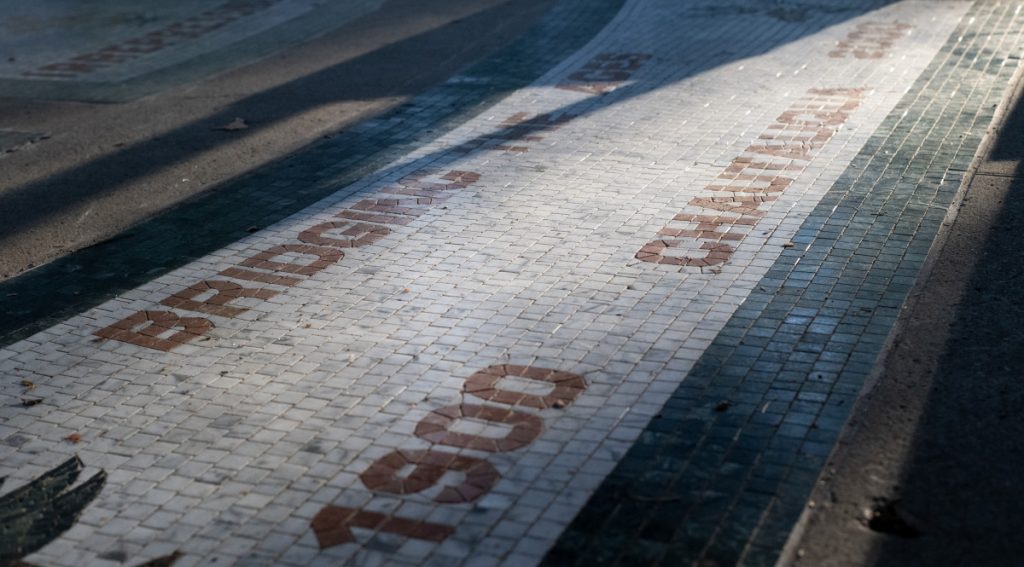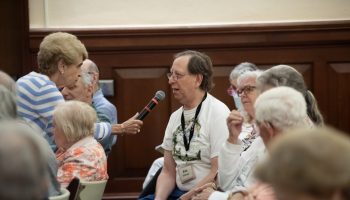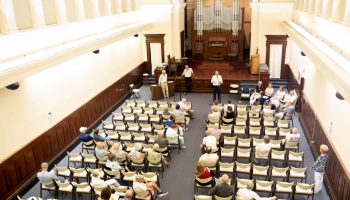
Susie Anderson
Staff Writer
As Chautauquans walk into the Hall of Philosophy any number of events — from the Interfaith Lecture Series or the Chautauqua Literary and Scientific Circle presentations during the summer, to a wedding or gathering in the off-season — they will notice a new shine beneath their feet. Fourteen of the 51 historic class mosaics of the CLSC have been restored, marking the second full year in a five-year repair plan to preserve a unique part of Chautauqua’s legacy.
“It’s an encyclopedia on the ground, and it’s telling you the history of Chautauqua,” said Karen Paul, vice president of the CLSC Class of 2000.
Each mosaic embedded into the floor of the Hall of Philosophy represents a CLSC graduating class — often depicting its symbol, plant and motto — dating back to the earliest days of Chautauqua’s reading program. The Class of 2000, the last to be memorialized in the floor, is now spearheading the campaign to repair the integral part of CLSC history.
Paul has partnered with Ryan Boughton — Associate AIA Member and the Institution’s administrator of architectural and land use regulations and capital projects manager — and local artist Denise Stebbins to breathe life back into the mosaics. Since the inaugural “Pioneer Class” of the CLSC graduated in 1882, the wear and tear of activity on the site has resulted in 37 of the 51 mosaics needing repair.
The project began in 2000 under the guidance of CLSC Class of 2000 President Tom Rowe, who worked on repairs for 17 years until his health began to decline, and the Institution oversaw minor repairs for the next seven years. Initially a $10,000 endowment, the efforts of Paul and community members have garnered $51,000 across 250 people to work toward the goal of completion. Anyone interested in contributing to the cause can do so at donorbox.org/the-mosaic-project.That funding will be used not only for artistic restoration, but also for surrounding concrete repairs and protective sealing to prevent further damage.
Paul emphasized that the community has rallied to the cause, inside and outside the gates. From community members such as Ruth Nelson selling T-shirts and tote bags decorated with mosaics to Jamestown Kitchen and Tile generously gifting Paul free tiles, the community has risen to the cause.
The repairs are more than tilework — they are a preservation of Institution history. Stebbins herself was married in the Hall of Philosophy. Paul recalled a time in which Stebbins spent an entire night retiling a mosaic, with her husband holding up a flashlight at 11:30 p.m. in advance of a wedding the next morning.
“I’ve learned so much by working with an artist,” Paul said. “She is so particular.”
The effort of tile-matching and acquiring tile is no easy feat. Paul shared that she has reached out to over 100 public and private companies in an effort to find proper fits for a largely unknown tile history.
“We had no record of where any tiles came from,” Paul said.
To prevent further gaps in knowledge, Paul and the others are consciously cataloguing details about the tiles to help with future maintenance. Boughton emphasized the importance of the shift.
“Moving forward, we’ll have all the information — products, specs, tile types — and Karen’s also compiled the history behind a lot of the mosaics,” he said.
Paul is working with Daily reporter and author Mary Lee Talbot to compile the history of the mosaics into a book, adding a literary dimension to the artistic restoration.
The Hall of Philosophy, a National Historic Landmark and included on the National Register of Historic Places as part of the Chautauqua Historic District, is one of Chautauqua’s most beloved and iconic structures. The restoration is not merely aesthetic, but a reflection of the community’s commitment to preserving its shared heritage.
“With restoration projects like this that have been fully grassroots-led by enthusiastic community members, it really shows how much this community cares about the place and how much they want to support things that mean a lot to everybody that comes here,” Boughton said.
As the project aims for completion in 2028 to celebrate the 150th anniversary of the CLSC’s creation, Paul has given lectures throughout the summer to update Chautauquans on the progress and been approached by ushers to compliment the difference that has been made.
“I think it’s brought a lot of awareness to people who never before stopped to look at the mosaics,” she said.
Alongside the physical restoration, the Institution’s grounds team has changed its approach to maintenance — washing the floor by hand and avoiding placing benches on them to reduce damage. Looking to the future of the project, Paul expressed gratitude to the community members involved and the Institution.
“We couldn’t have done the project without Chautauqua helping us,” Paul said.




